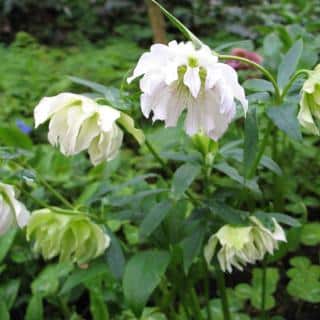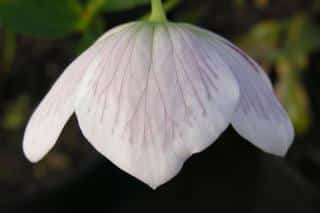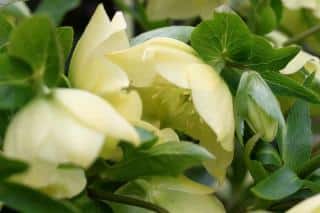

Though it’s certainly the most famous one, Helleborus niger isn’t the only white hellebore in the world.
There are indeed a good twenty species within the Helleborus genus, each of which is again subdivided into many varieties. Of these, there are quite a few hellebore with white flowers.
The Christmas Rose is without a doubt the most acclaimed white-blooming hellebore. But its fame doesn’t mean it’s an easy plant to grow: it’s actually among the more delicate varieties. Indeed, this botanical hellebore is a perennial plant that only grows in chalky soil that is both soft and fertile.
It spreads very slowly at the start, but in the end the Christmas Rose will just keep getting more and more lush, nearly doubling the number of flowers it bears every year.
 A resistant plant that is extremely cold-hardy, it copes surprisingly well with summer drought – though cool soil remains its all-time favorite environment.
A resistant plant that is extremely cold-hardy, it copes surprisingly well with summer drought – though cool soil remains its all-time favorite environment.
Helleborus niger is also unique in that its flowers hover at about one foot high (30 cm). It has a splendid pure white blooming sometimes tinted with pink. This burst of light illuminates its supple, dark green leaves. The simple flowers, shaped like white cups, appear in part shade. As the blooming draws on, flowers take on a green or purple-pink hue.
Note that you might also come across rarer white and double-flowered ‘niger’ hellebores, too. This is a particularly original variety: all winter long, it produces double flowers (meaning they have several layers of petals) that are an immaculate white color.
Double-flowered white hellebores are among the rarest Christmas Rose varieties.
Helleborus x nigercor is a sterile hybrid that results from the cross-pollination of Helleborus niger and Helleborus argutifolius (the Corsican hellebore). Nigercors hellebores are very vigorous and resistant varieties that love rich, heavy soil (loosened up a bit for the roots), and part shade. These bushy perennials have delectable evergreen foliage.
 They’ll resist temperatures as cold as -4°F (-20°C)! From December to March, these white hellebores bear many large flowers with pinkish white corollas.
They’ll resist temperatures as cold as -4°F (-20°C)! From December to March, these white hellebores bear many large flowers with pinkish white corollas.
Among the most striking white-flowered Helleborus nigercors specimens are:
They’re both particularly remarkable.
This white hellebore was recently developed in France. It’s a perennial that is both resilient and hardy, perfectly suited to grow as edges along shrub beds. Other intended landscaping purposes for it include ground cover and also simply planting in wide pots.
An easy-to-grow hellebore, the Paradenia will thrive almost anywhere, even in heavy, chalky soil, as long as its in the shade or at least in sunny spot that doesn’t get scorching hot.
This white hellebore is found appealing by many for its abundant and long-lasting winter blooming. It typically counts a number of large, white simple flowers that form a crown above the elegant dark green evergreen leafage.
This Oriental hellebore, sometimes called the Rose of Lent, is a cold-hardy perennial that resists temps down to 5°F (-15°C). This forgiving and easy-to-grow plant will settle right in under shrubs in a growing bed, helping to garnish the lower portions of mixed borders, or in a pot. Not a demanding plant at all: the Lenten Rose even does great in heavy soil. It loves shaded spots, or, if not available, sun-filled areas that won’t get too hot.
 The Anemone White oriental hellebore is a bushy variety: it forms compact 1½ foot clumps (40 cm). The shiny dark green evergreen leaves are like a velvet cushion that showcase the white simple flower clusters that appear from February to April.
The Anemone White oriental hellebore is a bushy variety: it forms compact 1½ foot clumps (40 cm). The shiny dark green evergreen leaves are like a velvet cushion that showcase the white simple flower clusters that appear from February to April.
Each flower is cup-shaped with a creamy white color, bejeweled with a central white collar: all in all, quite deserving of the “Anemone flower” nickname.
Did you know? A tree has summer flowers that are very similar to those of white hellebore: cup-shaped and drooping downwards. Discover Eucryphia!
To learn more, read: